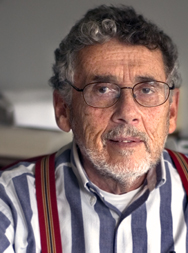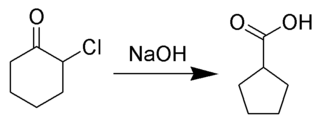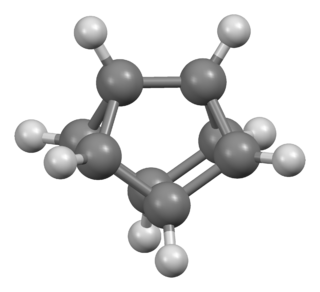Cubane is a synthetic hydrocarbon compound with the formula C8H8, and that consists of eight carbon atoms arranged at the corners of a cube, with one hydrogen atom attached to each carbon atom. A solid crystalline substance, cubane is one of the Platonic hydrocarbons and a member of the prismanes. It was first synthesized in 1964 by Philip Eaton and Thomas Cole. Before this work, Eaton believed that cubane would be impossible to synthesize due to the "required 90 degree bond angles". The cubic shape requires the carbon atoms to adopt an unusually sharp 90° bonding angle, which would be highly strained as compared to the 109.45° angle of a tetrahedral carbon. Once formed, cubane is quite kinetically stable, due to a lack of readily available decomposition paths. It is the simplest hydrocarbon with octahedral symmetry.

Philip E. Eaton was an American chemist. He served as Professor Emeritus of Chemistry at the University of Chicago. Eaton and his fellow researchers were the first to synthesize the "impossible" cubane molecule in 1964.

Dinitrogen pentoxide is the chemical compound with the formula N2O5. It is one of the binary nitrogen oxides, a family of compounds that only contain nitrogen and oxygen. It exists as colourless crystals that sublime slightly above room temperature, yielding a colorless gas.

Hexanitrobenzene, also known as HNB, is a nitrobenzene compound in which six nitro groups are bonded to all six positions of a central benzene ring. is a high-density explosive compound with chemical formula C6N6O12, obtained by oxidizing the amine group of pentanitroaniline with hydrogen peroxide in sulfuric acid.

In organic chemistry, nitro compounds are organic compounds that contain one or more nitro functional groups. The nitro group is one of the most common explosophores used globally. The nitro group is also strongly electron-withdrawing. Because of this property, C−H bonds alpha (adjacent) to the nitro group can be acidic. For similar reasons, the presence of nitro groups in aromatic compounds retards electrophilic aromatic substitution but facilitates nucleophilic aromatic substitution. Nitro groups are rarely found in nature. They are almost invariably produced by nitration reactions starting with nitric acid.

Ozonide is the polyatomic anion O−3. Cyclic organic compounds formed by the addition of ozone to an alkene are also called ozonides.

Prismane or 'Ladenburg benzene' is a polycyclic hydrocarbon with the formula C6H6. It is an isomer of benzene, specifically a valence isomer. Prismane is far less stable than benzene. The carbon (and hydrogen) atoms of the prismane molecule are arranged in the shape of a six-atom triangular prism—this compound is the parent and simplest member of the prismanes class of molecules. Albert Ladenburg proposed this structure for the compound now known as benzene. The compound was not synthesized until 1973.

The Favorskii rearrangement is principally a rearrangement of cyclopropanones and α-halo ketones that leads to carboxylic acid derivatives. In the case of cyclic α-halo ketones, the Favorskii rearrangement constitutes a ring contraction. This rearrangement takes place in the presence of a base, sometimes hydroxide, to yield a carboxylic acid, but usually either an alkoxide base or an amine to yield an ester or an amide, respectively. α,α'-Dihaloketones eliminate HX under the reaction conditions to give α,β-unsaturated carbonyl compounds.

Heptanitrocubane is an experimental high explosive based on the cubic eight-carbon cubane molecule and closely related to octanitrocubane. Seven of the eight hydrogen atoms at the corners of the cubane molecule are replaced by nitro groups, giving the final molecular formula C8H(NO2)7.
Polyvinyl nitrate (abbreviated: PVN) is a high-energy polymer with the idealized formula of [CH2CH(ONO2)]. Polyvinyl nitrate is a long carbon chain (polymer) with nitrate groups bonded randomly along the chain. PVN is a white, fibrous solid, and is soluble in polar organic solvents such as acetone. PVN can be prepared by nitrating polyvinyl alcohol with an excess of nitric acid. Because PVN is also a nitrate ester such as nitroglycerin (a common explosive), it exhibits energetic properties and is commonly used in explosives and propellants.

Cuneane is a saturated hydrocarbon with the formula C8H8 and a 3D structure resembling a wedge, hence the name. Cuneane may be produced from cubane by metal-ion-catalyzed σ-bond rearrangement. Similar reactions are known for homocubane and bishomocubane.

Xylitol pentanitrate (XPN) is a nitrated ester primary explosive first synthesized in 1891 by Gabriel Bertrand. Law enforcement has taken an interest in XPN along with erythritol tetranitrate (ETN) and pentaerythritol tetranitrate (PETN) due to their ease of synthesis, which makes them accessible to amateur chemists and terrorists.

Ammonium dinitramide (ADN) is the ammonium salt of dinitraminic acid. ADN decomposes under heat to leave only nitrogen, oxygen, and water. The ions are the ammonium ion NH4+ and the dinitramide N(NO2)2−.

Basketane is a polycyclic alkane with the chemical formula C10H12. The name is taken from its structural similarity to a basket shape. Basketane was first synthesized in 1966, independently by Masamune and Dauben and Whalen. A patent application published in 1988 used basketane, which is a hydrocarbon, as a source material in doping thin diamond layers because of the molecule's high vapor pressure, carbon ring structure, and fewer hydrogen-to-carbon bond ratio.

Octaazacubane is a hypothetical explosive allotrope of nitrogen with formula N8, whose molecules have eight atoms arranged into a cube. (By comparison, nitrogen usually occurs as the diatomic molecule N2.) It can be regarded as a cubane-type cluster, where all eight corners are nitrogen atoms bonded along the edges. It is predicted to be a metastable molecule, in which despite the thermodynamic instability caused by bond strain, and the high energy of the N–N single bonds, the molecule remains kinetically stable for reasons of orbital symmetry.

Tetranitrogen is a neutrally charged polynitrogen allotrope of the chemical formula N
4 and consists of four nitrogen atoms. The tetranitrogen cation is the positively charged ion, N+
4, which is more stable than the neutral tetranitrogen molecule and is thus more studied.

Tetranitratoxycarbon, systematic name tetra(nitrato-O,O,O-methyl)methane, is a hypothetical molecule that was proposed by Clara Lazen, a fifth-grader in Kansas City, Missouri, who conceived of its structure and built a model in 2012. She is credited as co-author of a scientific paper on the molecule, which uses computational chemistry to predict that the molecule could actually exist.

Karl Otto Christe is an inorganic chemist. He is the best reference in respectful handling of a huge number of extremely reactive components and his extensive experience in fluorine chemistry earned him the title of 'The Fluorine God'. His research covers fluorine chemistry of nitrogen and halogens and the synthesis of new energetic materials.

In organic chemistry, paddlane is any member of a class of tricyclic saturated hydrocarbons having two bridgehead carbon atoms joined by four bridges. The name derives from a supposed resemblance of the molecule to a paddle wheel: namely, the rings would be the propeller's blades, and the shared carbon atoms would be its axis.

A carbon nanothread is a sp3-bonded, one-dimensional carbon crystalline nanomaterial. The tetrahedral sp3-bonding of its carbon is similar to that of diamond. Nanothreads are only a few atoms across, more than 20,000 times thinner than a human hair. They consist of a stiff, strong carbon core surrounded by hydrogen atoms. Carbon nanotubes, although also one-dimensional nanomaterials, in contrast have sp2-carbon bonding as is found in graphite. The smallest carbon nanothread has a diameter of only 0.2 nanometers, much smaller than the diameter of a single-wall carbon nanotube.




















